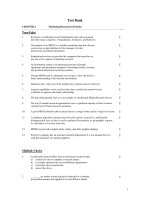Lecture Marketing research (12th edition) - Chapter 13: Experimentation
Bạn đang xem bản rút gọn của tài liệu. Xem và tải ngay bản đầy đủ của tài liệu tại đây (761.37 KB, 40 trang )
1
Marketing Research
Aaker, Kumar,
Leone and Day
Twelfth Edition
Instructor’s
2
Chapter Thirteen
Experimentation
Marketing Research 12th Edition
3
Experiments
•
Studies in which conditions are controlled so that one or
more independent variable(s) can be manipulated to test a
hypothesis about a dependent variable
Marketing Research 12th Edition
4
Experimental vs. Descriptive Research
Marketing Research 12th Edition
5
What Constitutes Causality?
•
•
•
•
A change in one variable will produce a change in another
Concept of a precondition influencing a variable of interest
Time Sequence
Lack of association suggests absence of causation
Attitude
Behavior
Marketing Research 12th Edition
6
Direction of Causation Issue
Approach 1: Determining the direction of causation
▫ Draw on logic and previous theory
Whether one of the variables is relatively fixed and unalterable
Approach 2: Consider the fact that there is usually a time
lag exists between cause and effect
▫
The causal variable should have a positive association with the
effect variable lagged in time
Marketing Research 12th Edition
7
Conditions for Valid Causal Inference
Marketing Research 12th Edition
8
Laboratory and Field experiments
Marketing Research 12th Edition
9
Laboratory Experiments
•
•
•
•
•
•
Experiments in which the experimental treatment is
introduced in an artificial or laboratory setting
Tend to be artificial
Testing effect exists as respondents are aware of being in
a test and may not respond naturally
Results may not have external validity
Least costly and allow experimenter greater control
over the experiment
Alternative explanations of results are reduced,
increasing internal validity
Marketing Research 12th Edition
10
Field Experiments
•
•
•
•
•
•
Research study in which one or more independent
variables are manipulated by the experimenter under
carefully controlled conditions as the situation will permit
Experimental treatment or intervention introduced in a
completely natural setting
Response tends to be natural
Tend to have much greater external validity
Difficult to control
Competing explanations for results exist
Marketing Research 12th Edition
11
Threats to Experimental Validity
Threats to Internal validity
Marketing Research 12th Edition
12
Threats to Experimental Validity (Contd.)
Threats to External validity
Marketing Research 12th Edition
13
Issues in Experimental Research
•
•
•
What type of experimental design should be used?
Should the experiment be performed in a "laboratory"
setting or in the "field"?
What are the internal and external threats to the validity
of the experiment?
Marketing Research 12th Edition
14
Basic Symbols and Notations
O
a formal observation or measurement
X
exposure of test units in the study to the
experimental manipulation or treatment
EG
an experimental group of test units exposed
the experimental treatment
to
CG
a control group of test units participating in
experiment but not exposed to the
experimental treatment
the
R
random assignment of test units and
experimental treatments to groups.
Randomization increases
reliability
M
both the experimental group and the control
group are matched on the basis of some
relevant characteristics
Marketing Research 12th Edition
15
Types of Experimental Designs
Classical
▫
Considers only one treatment level of an independent variable at a
time
Statistical
▫
Allows for examining the impact of different treatment levels of an
independent variable and the impact of two or more independent
variables
Marketing Research 12th Edition
16
Classification of Experimental Designs
Marketing Research 12th Edition
17
Classical Designs Preexperimental
Designs
One Group, Afteronly Design
•
Apply the experimental treatment to a subject or group and measure the
results
EG X O
Leaves open the possibility that the results could be explained by events
external to the design
Marketing Research 12th Edition
18
Preexperimental Designs (Contd.)
Nonmatched Control Group Deign
•
Introduce a control group to control for history and
maturation
EG X O1
CG O2
Marketing Research 12th Edition
19
Preexperimental Designs (Contd.)
Matched Control Group Design
•
Matches experimental and control groups to
reduce selection bias
EG M X O1
CG M O2
Marketing Research 12th Edition
20
Preexperimental Designs (Contd.)
Onegroup, Before After Design
•
Improve control by adding before measure
EG O1 X O2
•
Before
measure adds sensitivity by adding another
method to control for confounding variables
Marketing Research 12th Edition
21
Preexperimental Designs (Contd.)
Threats to Experiment Validity in Onegroup, BeforeAfter
Design
•
•
Before Measure Effect
▫
May alert respondents to the fact that they are being studied
▫
Results in more socially desirable behavior
Mortality Effect
▫
•
Some subjects may stop participating in the experiment
Instrumentation Effect
▫
Results from a change in the measuring instrument
Marketing Research 12th Edition
22
Classical Designs – True Experimental
Designs
True experimental designs adopt random
assignment procedure and use one or more
control groups
Random Assignment
•
For any given assignment to a treatment, every
member of the universe has an equal probability
of being chosen
Marketing Research 12th Edition
23
True Experimental Designs (Contd.)
Two Group, Afteronly Design
•
Randomization can match test and control
groups on all dimensions simultaneously, given
a sufficient sample size
EG R X O1
CG R O2
There is no interaction effect of testing as there are no pretest
requirements
Marketing Research 12th Edition
24
True Experimental Designs (Contd.)
Twogroup, Beforeafter Design
•
Adds a control group to onegroup, before after design
•
Helps control for history and maturation
•
Controls for reactive effect of O1 and O2
EG R O1 X O2
CG R O3 O4
Marketing Research 12th Edition
25
True Experimental Designs (Contd.)
Solomon Four Group Design
EG R O1 X O2
CG R O3 O4
EG R X O5
CG R O6
•
•
This design is often prohibitively expensive
Provides power to control for before measure effect of O1 on both X and
O2
Marketing Research 12th Edition









